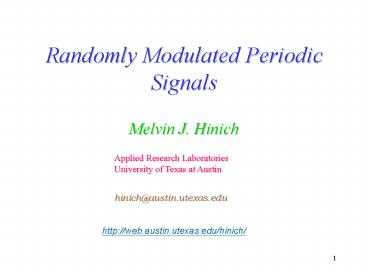Randomly Modulated Periodic Signals PowerPoint PPT Presentation
1 / 52
Title: Randomly Modulated Periodic Signals
1
Randomly Modulated Periodic Signals
- Melvin J. Hinich
Applied Research Laboratories University of Texas
at Austin
hinich_at_austin.utexas.edu
http//web.austin.utexas.edu/hinich/
2
Rotating Cylinder Data
3
Cat Brain EEG Seizure
4
Daily Sunspots
5
Hourly Alberta Electricity Demand
6
Hourly Alberta Electricity Prices
7
One Week of Yen/US Returns
8
Canadian /US Rates of Return
9
Bassoon Note
10
Flute Note
11
Definition of a RMP
A signal is called a randomly modulated
periodicity with period TNd if it is of the
form
12
Random Modulations
are jointly dependent random processes that
satisfy two conditions
Periodic block stationarity
13
Finite Dependence
Condition needed to ensure that averaging over
frames yields asymptotically gaussian estimates
are independently distributed if
14
Fourier Series for Components
15
Signal Plus Noise
The modulation is part of the signal
It is not measurement noise
16
Artificial Data Examples
17
Five Standard Deviations
18
Three Standard Deviations
19
Two Standard Deviations
20
One Standard Deviation
21
No Correlation in the Modulation
22
Block Data into Frames
The data block is divided into M frames of
length T
T is chosen by the user to be the period of the
periodic component
The t-th observation in the mth frame is
23
Signal Coherence Function
24
Frame Rate Synchronization
The frame length T is chosen by the user to be
the hypothetical period of the randomly modulated
periodic signal.
If T is not an integer multiple of the true
period then coherence is lost.
25
Signal Coherence Spectrum
The signal-to-noise ratio is
26
Estimating Signal Coherence
27
Statistical Measure of Modulation SNR
28
Chi Squared Statistic
29
Coherent Part of the Mean Frame
30
Spectrum of the Variance
Fourier Series Expansion
31
Sunspot Spectra
32
(No Transcript)
33
(No Transcript)
34
Power Signal Coherence Spectra - Demand
35
Power Signal Coherence Spectra - Prices
36
Yen/ Spectrum Coherencies
37
Exchange Rates Data
25 exchange rate series sampled half-hourly for
the whole of 1996 with weekends removed. The
weekend period is from 2300 GMT on Friday when
North American financial centres close until
2300 GMT on Sunday when Australasian markets
open. The incorporation of such prices would lead
to spurious zero returns and would potentially
render trading strategies which recommended a buy
or sell at this time to be nonsensical. Removal
of these weekend observations leaves 12,575
observations for subsequent analysis.
38
Summary Statistics
39
Coherence Results I
40
Coherence Results II
41
Coherent Part of Yen/ Mean Frame
42
Descriptive Statistics of Canadian/US Daily Data
- Sample size 7569 20.7 Years
- Mean 0.557E-04 Std Dev 0.270E-02
- Skew 0.933E-01 Kurtosis 3.62
- Max value 0.191E-01 Min value
-0.184E-01 - Frames 40 Frame Length 186.8
- Frequencies in band 93
- Maximum coherence probability 0.999999
- Coherence threshold 0.35
43
Canadian/US Daily Data Spectra
44
Waterfall Spectrograms of RMPNoise SNR - 38
dB
45
Sigcoh Probability Waterfall of RMPNoise SNR -
38 dB
46
Waterfall Spectrograms of RMPNoise SNR - 44
dB
47
Sigcoh Probability Waterfall of RMPNoise SNR -
44 dB
48
Winglet Vibration Data
49
Winglet Spectrum Coherencies
50
Prewhitened Winglet Spectra
51
Tuned Prewhitened Winglet Spectra
52
Noise Like Signal

